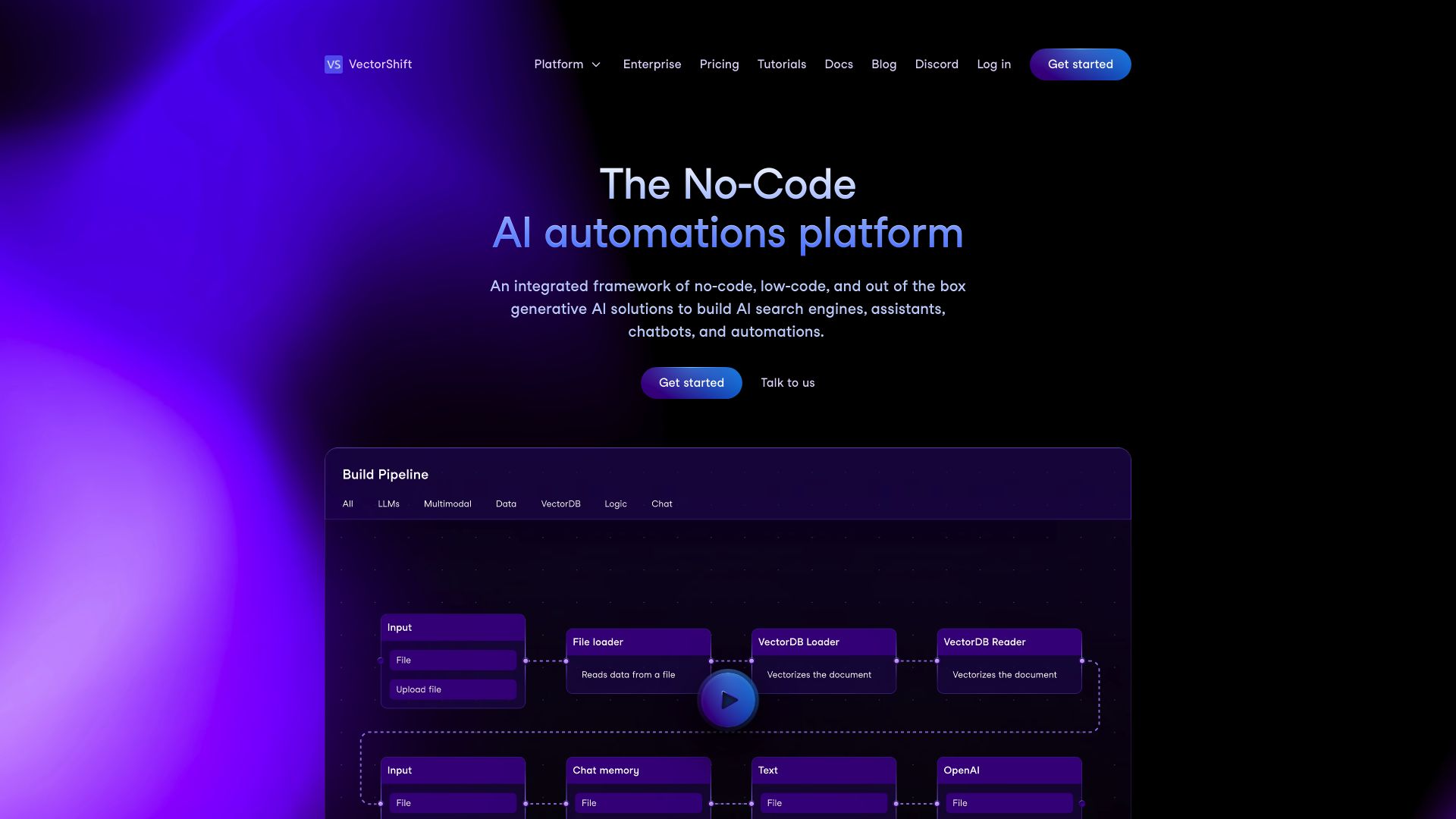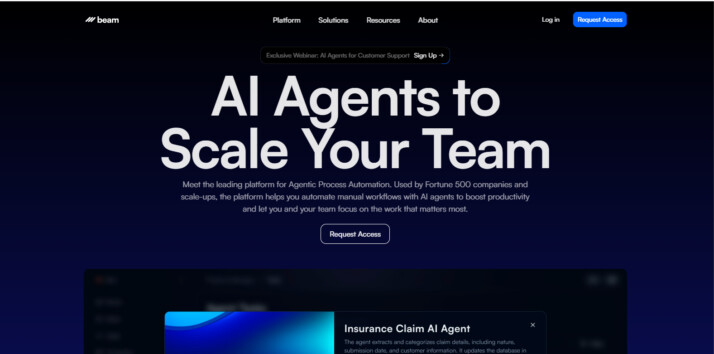VectorShift vs. Beam AI: Comparing AI Agent Builders
AI agent builders revolutionize how businesses automate tasks, streamline workflows, and enhance productivity. VectorShift vs. Beam AI stand out as powerful platforms in this domain, each offering unique approaches to AI-driven automation. This comparison delves into their key features, strengths, and potential limitations, providing insights for developers, business leaders, and AI enthusiasts alike. We’ll explore how these platforms empower users to create sophisticated AI workflows, their integration capabilities, and deployment options. By examining VectorShift’s versatile no-code builder alongside Beam AI’s specialized Agentic Process Automations, readers will gain a comprehensive understanding of each platform’s value proposition. Ultimately, this analysis aims to guide decision-makers in selecting the AI agent builder that best aligns with their organizational needs and technical requirements.
VectorShift Overview
VectorShift empowers users to design, build, and manage generative AI workflows and automations through a versatile platform. The software caters to both technical and non-technical users with its dual-interface approach, offering a no-code builder and a code SDK. This flexibility allows VectorShift to address a wide range of AI applications, from chatbots and search functionalities to complex automations and content creation tasks.
At the core of VectorShift’s offering is the pipeline dashboard, where users can create AI workflows from scratch or leverage pre-built templates. This feature streamlines the deployment process, making it efficient for users to implement AI solutions tailored to their specific needs. The platform’s extensive integration capabilities, including connections with popular services like Google Drive, Slack, and Airtable, enable centralized data management and seamless synchronization across applications.
VectorShift excels in its comprehensive automation capabilities, allowing users to create end-to-end workflows, schedule tasks, and trigger actions based on predefined events.
VectorShift excels in its comprehensive automation capabilities, allowing users to create end-to-end workflows, schedule tasks, and trigger actions based on predefined events. The platform’s knowledge base functionality enhances AI performance by centralizing data and enabling semantic searches, contributing to more accurate and relevant information retrieval. VectorShift also offers flexible deployment options, allowing users to implement their AI solutions as chatbots, automations, or search functions, with various customization and export possibilities.


While VectorShift provides a robust set of features, users should consider potential limitations. The platform’s effectiveness may vary depending on the complexity of the AI workflows and the specific integration requirements of individual projects. Additionally, as with many AI platforms, the quality of output depends heavily on the input data and the user’s ability to design effective workflows.
VectorShift positions itself as a solution for democratizing AI workflow creation and management. By offering tools that cater to users with varying levels of technical expertise, the platform aims to make AI technology more accessible and practical for businesses across industries. As organizations continue to explore AI applications, VectorShift’s combination of user-friendly interfaces, extensive integration options, and flexible deployment capabilities makes it a noteworthy contender in the AI agent builder market.
Beam AI Overview
Beam AI empowers organizations to create intelligent agents that automate repetitive tasks and boost productivity. Their platform, VectorShift, enables the development and deployment of Agentic Process Automations (APAs) capable of handling complex workflows across various business domains.
VectorShift’s no-code visual builder allows users to construct AI workflows using drag-and-drop interfaces, making advanced AI capabilities accessible to both technical and non-technical users. The platform supports multi-agent collaboration, enabling teams to create sophisticated automation solutions that can tackle intricate business processes.


Beam AI empowers organizations to create intelligent agents that automate repetitive tasks and boost productivity. Their platform, VectorShift, enables the development and deployment of Agentic Process Automations (APAs)…
Beam AI’s agents excel in areas such as data extraction, customer inquiry management, compliance automation, and order optimization. These APAs continuously learn and adapt, improving their accuracy and efficiency over time. The platform integrates with popular AI models like OpenAI’s GPT-3.5 Turbo, allowing users to leverage cutting-edge language processing capabilities in their workflows.
While Beam AI offers robust features for AI agent development, it may have limitations in certain areas. The platform’s focus on no-code solutions, while beneficial for accessibility, could potentially restrict advanced customization options for highly specialized use cases. Additionally, the absence of specific features like constrained alignment and IP control might pose challenges for organizations with stringent security requirements.
Beam AI emphasizes sustainability and efficiency, aiming to minimize steps in achieving goals and reduce human carbon footprints. Their vision aligns with the growing trend towards artificial general intelligence (AGI), positioning them as a forward-thinking player in the AI automation space. However, potential users should carefully evaluate whether Beam AI’s specific feature set aligns with their organization’s unique needs and technical requirements.
Feature Comparison
VectorShift and Beam AI offer robust platforms for building AI agents, but significant feature gaps exist between them. VectorShift provides a comprehensive no-code visual builder that enables users to create complex AI workflows through an intuitive drag-and-drop interface. This accessibility empowers both technical and non-technical users to develop sophisticated AI solutions. In contrast, Beam AI’s platform focuses more on pre-built Agentic Process Automations (APAs) tailored for specific business tasks, potentially limiting customization options for highly specialized use cases.
A key difference lies in their approach to agent deployment and management. VectorShift supports multiple environments for development and production, allowing users to test and refine their AI agents before full deployment. Beam AI’s documentation does not explicitly mention this feature, which could pose challenges for organizations requiring robust testing processes. Additionally, VectorShift’s platform includes debug tools and transparent workflow visualization, enhancing explainability and facilitating troubleshooting. Beam AI’s offerings in this area appear less comprehensive, potentially impacting users’ ability to fine-tune and optimize their AI agents effectively.
Security features also reveal notable gaps. While both platforms support data encryption and OAuth for integrations, VectorShift provides more granular control over API authentication and deployment options. Beam AI’s documentation lacks specifics on IP control and constrained alignment features, which are crucial for organizations with stringent security requirements. VectorShift’s ability to deploy agents as APIs, webhooks, and scheduled tasks offers greater flexibility in integration and automation scenarios, a capability not explicitly highlighted in Beam AI’s feature set.
Feature Comparison Table
| VectorShift | Beam AI | SmythOS | |
|---|---|---|---|
| CORE FEATURES | |||
| Hosted Agents (Dev, Production) | ❌ | ✅ | ✅ |
| Environments (Dev, Production) | ❌ | ✅ | ✅ |
| Visual Builder | ✅ | ❌ | ✅ |
| No-Code Options | ✅ | ❌ | ✅ |
| Autonomous Agents | ❌ | ✅ | ✅ |
| Explainability & Transparency | ❌ | ✅ | ✅ |
| Debug Tools | ❌ | ❌ | ✅ |
| Multimodal | ✅ | ❌ | ✅ |
| Multi-Agent Collaboration | ❌ | ✅ | ✅ |
| Audit Logs for Analytics | ❌ | ✅ | ✅ |
| SECURITY | |||
| Constrained Alignment | ❌ | ✅ | ✅ |
| Data Encryption | ❌ | ✅ | ✅ |
| IP Control | ❌ | ✅ | ✅ |
| COMPONENTS | |||
| Huggingface AIs | ❌ | ✅ | ✅ |
| Zapier APIs | ❌ | ✅ | ✅ |
| Classifiers | ❌ | ✅ | ✅ |
| Data Lakes | ❌ | ❌ | ✅ |
| DEPLOYMENT OPTIONS (EMBODIMENTS) | |||
| Staging Domains | ❌ | ✅ | ✅ |
| Production Domains | ❌ | ✅ | ✅ |
| Deploy as GPT | ❌ | ✅ | ✅ |
| DATA LAKE SUPPORT | |||
| Hosted Vector Database | ✅ | ❌ | ✅ |
| Sitemap Crawler | ❌ | ❌ | ✅ |
| YouTube Transcript Crawler | ✅ | ❌ | ✅ |
| URL Crawler | ✅ | ❌ | ✅ |
Best Alternative to VectorShift and Beam AI
SmythOS stands out as the superior alternative to VectorShift and Beam AI for agentic AI automation. Our platform combines powerful features with unmatched ease of use, empowering users to create sophisticated AI agents for unlimited use cases. SmythOS delivers a comprehensive solution that outperforms competitors in key areas.
Unlike VectorShift’s limited deployment options and Beam AI’s focus on pre-built automations, SmythOS offers unparalleled flexibility. Our intuitive drag-and-drop interface allows both technical and non-technical users to design complex AI workflows without extensive coding. This visual builder democratizes AI development, enabling rapid creation and deployment of custom agents for any business need.
SmythOS offers unparalleled flexibility. Our intuitive drag-and-drop interface allows both technical and non-technical users to design complex AI workflows without extensive coding.
SmythOS excels in scalability and integration capabilities. While VectorShift and Beam AI have constraints, we provide seamless API integrations, support for multiple AI models, and the ability to deploy agents across various platforms. This versatility ensures that our solution can adapt to growing business requirements and integrate smoothly with existing systems.
Security and transparency set SmythOS apart. We offer robust features like data encryption, OAuth support, and granular API controls that surpass VectorShift and Beam AI. Our platform also provides comprehensive debugging tools and workflow visualization, enhancing explainability and enabling users to fine-tune their AI agents effectively.
By choosing SmythOS, users gain access to a feature-rich platform that outperforms VectorShift and Beam AI in critical areas. Our solution combines power and accessibility, allowing businesses to harness the full potential of AI automation across unlimited use cases. Experience the future of AI agent development with SmythOS — the clear choice for those seeking superior performance, flexibility, and ease of use in agentic AI automation.
Conclusion
VectorShift and Beam AI offer compelling solutions for AI agent development, each with unique strengths. VectorShift’s dual-interface approach and extensive integration options provide flexibility for users of varying technical backgrounds. Beam AI’s focus on Agentic Process Automations (APAs) presents a specialized solution for business process optimization.
However, SmythOS emerges as the superior choice, offering unparalleled versatility and ease of use. Our drag-and-drop interface, coupled with support for over 300,000 integrations, empowers users to create sophisticated AI workflows without extensive coding knowledge. Unlike VectorShift and Beam AI, SmythOS provides a comprehensive ecosystem that seamlessly integrates various AI models, APIs, and data sources.
SmythOS stands out with its “Create Once, Deploy Anywhere” philosophy, allowing users to effortlessly deploy AI agents across multiple platforms. This flexibility, combined with our robust security features and scalability, makes SmythOS the ideal solution for businesses of all sizes looking to leverage AI technology effectively.
Ready to experience the future of AI agent development? Explore our diverse range of AI-powered agent templates to jumpstart your journey. For those eager to dive in, create a free SmythOS account and start building unlimited AI agents at no cost. Unleash the full potential of AI for your business with SmythOS – where innovation meets simplicity.
Last updated:
Disclaimer: The information presented in this article is for general informational purposes only and is provided as is. While we strive to keep the content up-to-date and accurate, we make no representations or warranties of any kind, express or implied, about the completeness, accuracy, reliability, suitability, or availability of the information contained in this article.
Any reliance you place on such information is strictly at your own risk. We reserve the right to make additions, deletions, or modifications to the contents of this article at any time without prior notice.
In no event will we be liable for any loss or damage including without limitation, indirect or consequential loss or damage, or any loss or damage whatsoever arising from loss of data, profits, or any other loss not specified herein arising out of, or in connection with, the use of this article.
Despite our best efforts, this article may contain oversights, errors, or omissions. If you notice any inaccuracies or have concerns about the content, please report them through our content feedback form. Your input helps us maintain the quality and reliability of our information.
